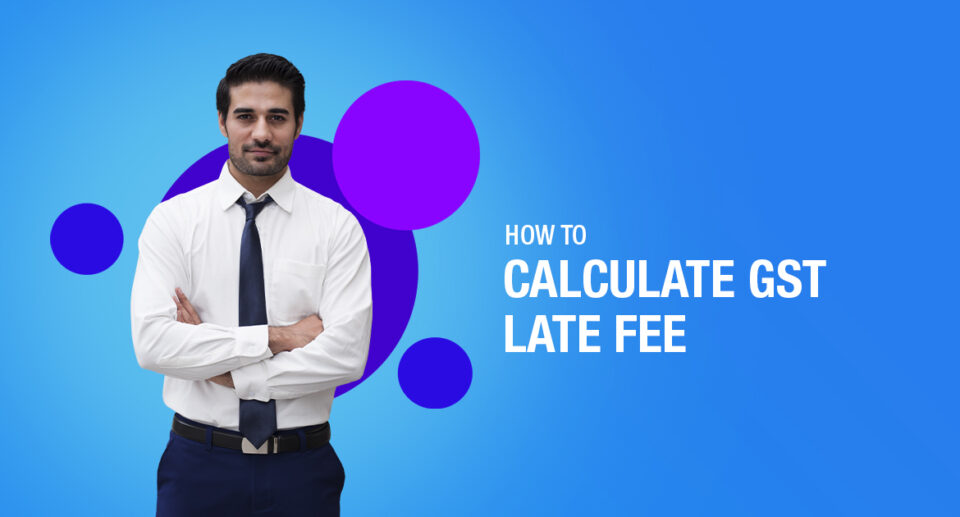How to Calculate GST Late Fee The Easy Way

Have you got charged for paying GST late fee and do not have any knowledge regarding it? Well, don’t worry you have clicked on the right article. Here you will find the important information about the same.
Goods and Service Tax (GST) is a tax levied on the supply of most goods and services. The tax applies to any transaction involving the supply of a taxable item.
The tax is paid on the GST portal after all the adjustments have been done and the successful payment is shown in the ledger named ‘Cash and Credit Ledger of the portal.
Filing GST return the right way is important for the taxpayers as any delay from the end of them will be strictly considered and a penalty will be charged.
The late fee penalty and interest on late payment vary according to the due dates and types of returns. The late fees are to be paid in cash on the portal of GST. The penalty is charged on a per-day basis every month and the payment has to be done on the 20th of the next month.
What is GST Return?
GSTR or GST Return is a document in which specific details of the registered taxpayer are written like income, sales, purchase, expenditure. A businessman compulsorily has to file for the same.
The process of filing a GST Return is online and the GST payment is calculated for total sales, purchases, tax paid by buyers and businesses. A collective report is made for the same.
Businesses who have turnover less than ₹5 crores in the previous financial year can file for return monthly or quarterly whereas businesses with a turnover of more than ₹5 crores have to file it monthly.
The late filing of the return can attract a penalty of the late fee so it is important to file it accordingly.
There are 22 types of returns but the businesses have the option to file for only 11 that are being used actively as per the regimes of the Goods and Services Tax Act.
- GSTR 1- includes information about taxable goods or services and outward supplies.
- GSTR2A
- GSTR 2B
- GSTR2- information about inward supplies of taxable goods and services with ITC claim.
- GSTR3- includes details of total tax with monthly return details.
- GSTR 3B
- GSTR 4- details about quarterly return filing and compound tax liabilities.
- GSTR 5- details about NRI return filing.
- GSTR 5A
- GSTR 6- form for input service distributors.
- GSTR 7- return filing form for authorities initiating TDS
- GSTR 8- details about e-commerce businesses with collective tax amount according to sub-section 52
- GSTR 9- form to file the annual return
- GSTR 9A- annual return details related to registered person’s compounding tax under section 10
- GSTR 9C
- GSTR 10
- GSTR 11
Who needs to file the return?
Businesses who justify the following steps have to file for the GST return:
- Firms who are registered as a GST firm have to mandatorily file
- Every Taxable GST registration holder has to file it under GST Act
- Business with an annual turnover of 40 lakhs
- Business in the North-Eastern States or mountain regions with an annual turnover of 20 lakhs
- A firm with no sale of some period has to file for a NIL return
- A monthly return has to be filed for those businesses that have an annual turnover of more than 1.5 crores
- A person registered with GSTIN has to file the monthly returns and annual returns too
Steps For Online Filing Of GSTR
Follow these steps to file the return online.
- Visit the official website GST Portal
- Enter your username and password to log in
- A 15 digit identification number will be sent
- Upload all the bills and invoices on the GST portal to get an invoice reference number
- On the screen, an option “Return Dashboard” will appear, where you will have to fill the filing period for the return
- Tap on the option prepare online
- Enter the amount of late fee and interest if any
- Click on the save for saving all the mentioned details
- Click on submit
- Now you will have to clear all your liabilities, you can check your liability on the block named payment of tax
- Clicking on the offset liability will start payment
- A message of successful filing will appear after successful
- The GSTR form will get displayed with details
Required documents during filing
For successful filing of the GST return the following document will be needed:
- Invoice type
- Supply place
- Customer GSTIN
- Rate of GST
- Taxable value
- Summary details according to Harmonized System of Nomenclature(HSN)
- Invoice list and number
- The applicable amount of CGST, SGST, IGST
- Debit or Credit note
- Combined Sales of intra and interstate
Check the status of GSTR
After successfully filing for a return, the person can check the status to be assured that it has been done. You can follow these simple steps for checking:
- Open the official website of GST
- It will require your username and password to log in
- Click on service to choose “returns”
- select “track return status”
- A drop-down menu will appear and then tap the status of the “return”
- Tap search and the status will be shown
Also Read: GCP billing export
How to Calculate GST Late Fee?
Here is the list of the late fee amount charged for all the GST returns:
- Under GSTR-3B the chargeable fee for inter-state supplies where taxes like CGST and SGST are applied is ₹25 per day each which makes the total fee ₹50 per day
- Again under GSTR-3B, the chargeable fee for inter-state supplies where IGST is applied is ₹50 per day
- The minimum late fee is ₹5000 for each return
- If no return or NIL return has been filed, then the late fee charged for CGST and SGST is ₹10 per day while for IGST it is ₹20 per day
- For annual returns, the fee per day is ₹100 for both CGST and SGST
- Under GSTR 1the fee charged by the authority is ₹50 per day and the maximum of ₹10,000
- The fee charged under GSTR 4 is the same as GSTR 1 in both sales and NIL returns
- GSTR 10 or the final return, the fee charged is ₹200 per day
Let’s take an example to understand these numbers.
A person registered himself under GST on 20 March but forgot to file under GSTR 3B before the next 20th. He then filed his return on 1 May, so the delay of 10 days is there and the fee for it will be charged for 10 days;
- If he has done sales during this period, the fee will be ₹50×10 days which is equal to ₹500
- If in case no sale has been done, he will have to pay ₹200(₹20×10 days)
The extension may be given by the government for the due dates and the return has to be filed within the extended date.
Interest charged on late filing
Interest along with the late fees is also charged under GST return late filing. Interest is calculated on the Gross GST liability and is charged from the next day from the due payment of the tax. Interest charged under GST:
- If GST payment is delayed the amount of interest charged is 18% per annum
- If there is an excess reduction of tax liability then 24% of interest is charged per annum
- If there is an undue claim of ITC then the interest amount is 24% per annum
Let us continue the above example if the person has managed to make sales of say ₹2,00,000 in March and the amount payable for GST by him is ₹24,000. The net GST amount is ₹20,000 and the input tax credit is ₹4000 for March.
So the liability under his GST is ₹20,000 which he has to pay till the 20th of April since he did not file his GSTR in April but in May, he has to pay the interest too for 10 days delay.
Calculation of interest under GST:
Rate of Interest = 18% (sales are there)
Number of Days = 10 days
Gross GST amount = ₹24,000
Interest = 24,000 x 18/100 x 10/365
= ₹118.36(approx)
GST Fee Waiver Notification 2021
The finance ministry has extended the date for the payment of late fees under the amnesty scheme of GST. Earlier the date was 31 August 2021, but now the late fee payers can pay till 30 November 2021.
Taxpayers who have not filed their GSTR between 1 June and 31 August can now do it at the end of November. The ministry further said that “the extension is for those who have been registered under clause (b) or (c) of section 29(2) of the CGST Act.”
The extension is done keeping in mind the situation of the pandemic because some of the registrations were cancelled.
Before the extension, a new change had also been done for filing the form GSTR 3B and form GSTR 1. Now the companies will have to file using the Electronic Verification Code(EVC) which was earlier done with Digital Signature Certificate.
This was implemented from 21 April 2021 to 31 August 2021, which is now extended to October 2021.
Also Read: How to change Trade name in GST portal?
How Lio Can Help?
Lio is a helpful platform for organizing your business-related data including invoices, debit notes, or credit notes. This is a mobile integrated platform that helps in the easy finding of some valuable and daily required documents as you can collect them in one place.
Being its taxable amount for GST return filing it provides you with datasheets and templates for each category. It is a secure app that saves your data and helps in managing your business.
Not downloaded the Lio App yet? Here is how you can start with Lio App.
Step 1: Select the Language you want to work on. Lio for Android

Step 2: Create your account using your Phone Number or Email Id.

Verify the OTP and you are good to go.
Step 3: Select a template in which you want to add your data.

Add your Data with our Free Cloud Storage.
Step 4: All Done? Share and Collaborate with your contacts.

Conclusion
I hope this article helps you in understanding GST late free. It is mandatory to file for GST returns for the business that comes in the regime of the Goods and Service Tax Act, 2017. If not filed late fee and interest is charged by the authority and it is automatically shown on the portal.
You can follow the steps written in the article for filing the return. If you have missed filing for the return, you can get details about the same. Other information like the extension date is also mentioned.
Frequently Asked Questions(FAQs)
Is it important to file for a GST return?
If your business comes under the specifications prescribed in the act you have to file for the return compulsorily.
What is the meaning of NIL return?
When there are no sales done by the business for some specific period, the businessman has to file for a NIL return.
What is the amount of late fee under GSTR 3B?
The amount is ₹50 which includes both CGST and SGST.
Is interest with the GST late fee necessary to be paid?
Yes, you will have to pay the late fee along with interest according to the delay in the days.
Till When can the taxpayers pay for the GST late fee?
The Finance Ministry has extended the date to 30 November 2021 which was 31 August earlier.









6 Comments
Please tell me if there is a late fee for GST 9.
Hello Madhu,
According to the GSTR-9 annual return form’s penalty requirements, the taxpayer is required to pay a penalty of Rs. 200 each day, of which Rs. 100 is made up of SGST and Rs. 100 is made up of CGST.
Very well explanation of a very big problem. Thank you for sharing it. keep posting the solutions of other GST related issues too.
Hello Amish,
Thank you for your kind words.
I’m delighted this article was advantageous to you.
I will certainly publish other GST-related articles soon.
The effort you have made is commendable. This is such a vast topic, but you have detailed it in such a manner that it isn’t mundane. Amazing job!
Hello Khusbhu,
I appreciate your nice words.
I’m glad this article piqued your curiosity.
Enjoy your reading.